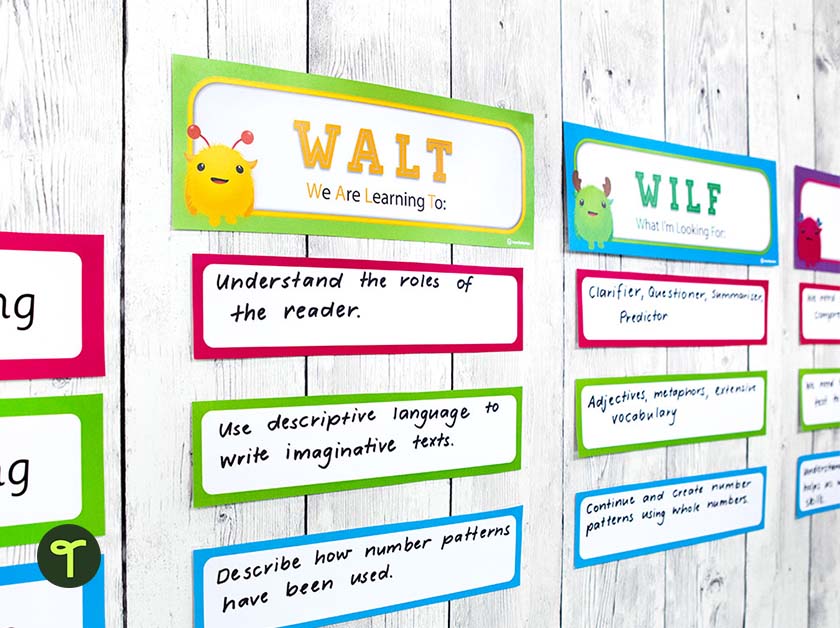Teachers, have you met WALT and WILF yet? Or perhaps you have met their friends TIB, WAGOLL, TILT, WINK, WILL, LI or SC? Have we lost you yet? These visual learning acronyms can be helpful for teachers in making learning explicit for their students, but if you have landed here, something tells us it’s because you are trying to decipher these acronyms and what they mean.
Or perhaps you know what they stand for, but you aren’t sure which ones to use and how to successfully implement this language into your classroom?
Don’t worry! The teachers on the Teach Starter team (hi, that’s us!) are ready to play letter detective and break down these popular teaching acronyms! Read on not just for an explainer of what WALT and WILF stand for, but a look at some other common teaching acronyms, and how to use them all with your primary students.
What Are WALT and WILF?
Let’s start at the beginning and look at WALT and WILF and break down the acronyms:
- WALT stands for We Are Learning To
- WILF stands for What I’m Looking For
Both of these acronyms were developed as a guide to help teachers identify learning goals and related success criteria at the beginning of each and every lesson. We realise teachers often do this regardless, but these simple acronyms can make it easier to make these clear to your students.
WALT, for example, helps to focus your students’ attention on the specific skill or concept that they will be learning during the lesson or activity. By using WALT, you can ensure your students understand the purpose of the lesson and can monitor their progress toward achieving the learning objective.
WILF, on the other hand, helps students understand the expectations for a task or assessment. WILF statements describe the criteria or standards that will be used to evaluate your students’ work, and they can be shared with students before or during the task. Using WILF, you can help students focus their efforts on meeting specific expectations and provide clear feedback to guide their learning. WILF can also be used to help students self-assess their work and identify areas for improvement.

Spot the WALT and WILF on this teacher’s ‘look what’s on’ display?
Let’s unpack these two acronyms further as these are the most popular and easiest to implement.
WALT (also referred to as ‘learning intention’) is all about outlining the objectives of the lesson. What will your students be learning about? What’s the learning goal or aim of the lesson? Make sure you use child-friendly language and focus on the learning outcome.
For example, a writing lesson goal may be ‘use descriptive language to write imaginative texts.’
WILF (sometimes called ‘success criteria’) is all about the ingredients the student needs to do, include or focus on in order to fulfill the learning outcome (WALT). Make sure you include detailed information about your expectations of the students.
For example, the success criteria for the above writing goal may be ‘evidence of adjectives, metaphors and extensive vocabulary within your writing.’
Here’s another WALT and WILF example:
WALT: Write a story starter.
WILF: Describe the setting. Describe the characters. Explain the problem. Use powerful adjectives.
Displaying WALT and WILF in the Classroom
Using a visual reminder of your chosen acronyms in the classroom can help both you and your students make this part of the lesson structure.
By creating a display for each subject area you are more inclined to remember to define each of these for your students. We used our ready-to-print WALT and WILF Learning Goal Slips for Whiteboard and some of our editable tray labels to create this vibrant, eye-catching display:
What Does TIB Mean?
TIB is another acronym prompter that could also be included during the learning process. TIB stands for This Is Because. This acronym is all about allowing the students to clearly understand and make the connections between skills and learning and real-world problems, as well as applying their knowledge to a particular concept.
It’s important that your students know ‘why’ they are learning a particular concept and not just ‘because they have to!’
Check out this collection of explicit teaching acronym posters that can be slipped in a plastic sheet. Have students use a whiteboard marker to complete them at the beginning of each lesson!
More Explicit Teaching Acronyms
We have covered the three main acronyms that you could introduce into your classroom tomorrow with ease. There’s no surprise that each and every school and teacher likes to use their own acronyms or language.
It’s why you’ll find we’ve included a long, long list of acronyms (beyond WALT and WILF) in our learning goal resources for the classroom. which can get overwhelming. Rest assured, you don’t have to use all of these. In fact, we would strongly advise you to pick a couple of important acronyms and stick with the same language so your students don’t get confused and overwhelmed.
- WALT (We Are Learning To…)
- WILF (What I’m Looking For…)
- TIB (This Is Because…)
- WAGOLL (What A Good One Looks Like…)
- WILL (What It Looks Like…)
- TILT (Today I Learnt That…) and TILT (Today I Learnt To…)
- WINK (What I Now Know…)
- LI (Learning Intention…) — This is just like WALT
- SC (Success Criteria…) — This is just like WILF
- OLI (Our Learning Intention)
It’s important to check with your school and the chosen acronyms that are used across the board. Consistency is key in your classroom, but you’ll also want to consider the language the other teachers are going to use in years to come so you can prepare your students accordingly.









Comments